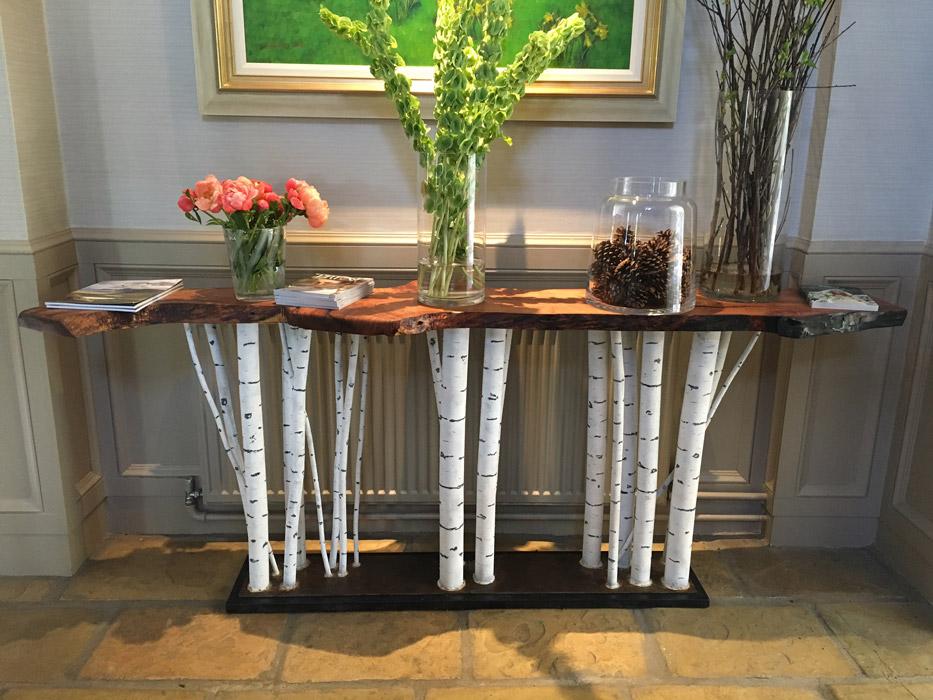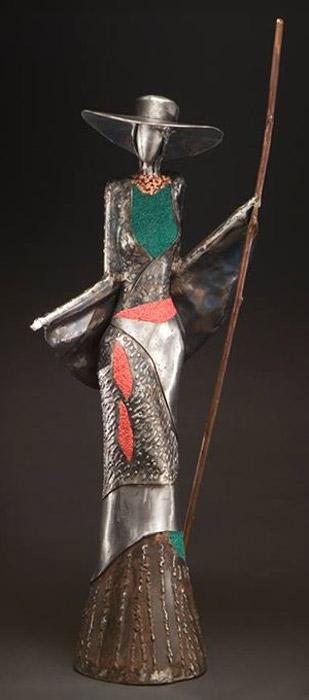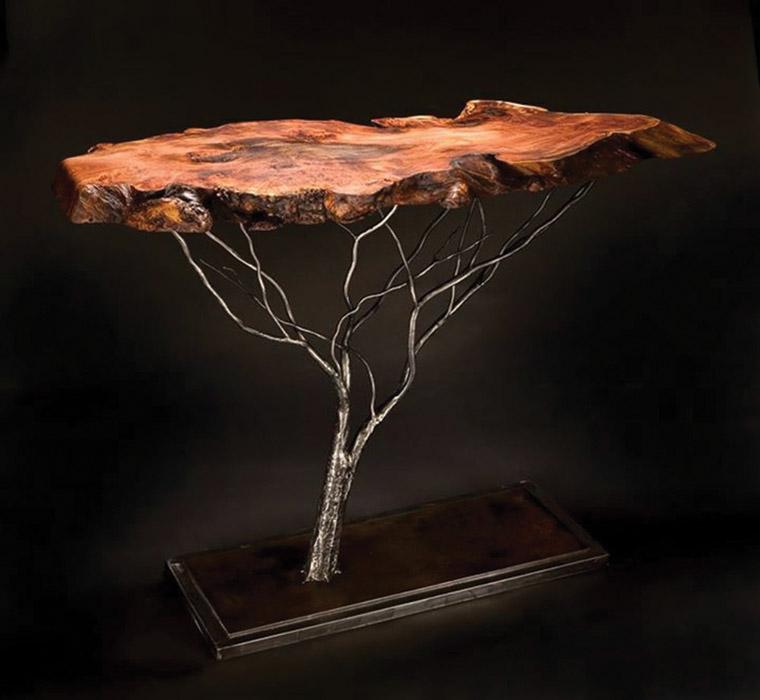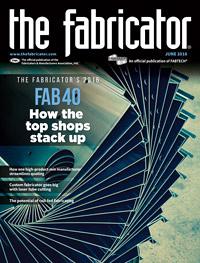- FMA
- The Fabricator
- FABTECH
- Canadian Metalworking
Categories
- Additive Manufacturing
- Aluminum Welding
- Arc Welding
- Assembly and Joining
- Automation and Robotics
- Bending and Forming
- Consumables
- Cutting and Weld Prep
- Electric Vehicles
- En Español
- Finishing
- Hydroforming
- Laser Cutting
- Laser Welding
- Machining
- Manufacturing Software
- Materials Handling
- Metals/Materials
- Oxyfuel Cutting
- Plasma Cutting
- Power Tools
- Punching and Other Holemaking
- Roll Forming
- Safety
- Sawing
- Shearing
- Shop Management
- Testing and Measuring
- Tube and Pipe Fabrication
- Tube and Pipe Production
- Waterjet Cutting
Industry Directory
Webcasts
Podcasts
FAB 40
Advertise
Subscribe
Account Login
Search
No experience necessary
Not a welder or an artist? Not a problem!
- By Amanda Carlson
- June 1, 2016
- Article
- Arc Welding

This live-edge table with an aspen tree base resides in its new home, the Marcliffe Hotel and Spa in Aberdeen, Scotland. Moser said his aspen trees look so realistic that it’s not uncommon for people to go up to them and touch them, just to see if they’re wood or metal.
Gary Moser was done with the grind. Nine years ago, after making a living as a masonry contractor in Scottsdale, Ariz., Moser had reached his limit with all of the frustrating aspects that seemed to take away from something that he enjoyed at one time. He worked hard and worked a lot, but he just got tired of having to fight for every single dollar that he earned. The whole thing just didn’t seem worth it anymore.
He wasn’t worried or stressed about what his next step would be. True, he had some hurdles to jump to make that plan happen, but he was confident he could make it work. Today Moser is happier than he’s ever been working for himself and making a living as a metal sculptor.
Challenge Accepted
Moser doesn’t follow the typical formula for a metal artist. No, he never welded previously, and no, he never was an artist. He was a husband, a dad, and a masonry contractor. Outside of enjoying Western art, a popular genre in the southwest U.S., it never really occurred to him to take it up until he took his family on a trip to Sedona, Ariz. While exploring local shops, Moser recalled, his kids randomly pointed out piece after piece, none of which looked particularly difficult to make.
“I said to them, ‘Oh, I can do that.’ Well, one Christmas they bought me some clay and said, ‘Here you go, make one.’ So over the weekend I made a horse lying down with a cowboy lying on his back with his feet up on the horse. My kids were like, ‘Oh my gosh, dad!’”
In the meantime, he got more and more tired of dealing with the minutia of his job.
“I would do a whole track of homes on a handshake, and then I started getting all of these contracts. The thicker the paperwork got, the worse I would get shafted, so it just got to where I was fighting all the time to get paid; I was fighting with my help; and fighting to get help. I would hire a guy and they had no work ethic. I just totally got fed-up,” Moser said.
When he went home and told his wife Linda that he was done, she politely reminded him that they needed to make money. But he assured her that things were going to be all right. His plan was going to work.
Moser entertained the idea of working with clay, but the region is already full of established clay artists. Plus, the material seemed too easy. He wanted to work with something more permanent, more challenging.
So he bought a “cheap wire feed welder,” and taught himself to weld by watching an instructional video. He found out the hard way that welding was tougher than he initially thought.
“The first thing I ever made—they have these big cookers that you take camping. They have legs and you hook them up to a propane tank. I made a box that fit on my camp trailer. You would open the door, the thing would fold out and slide out a little bit, and there was a table. So I did all this and thought it was so cool. Well, when I got up there and opened the door, I had about 20 little pieces lying in the bottom of the box because my welds were just crap.”

Moser creates “his ladies” with thick-gauge steel, texture created by weld metal, and turquoise and coral inlays that help make the surrounding steel pop.
But he learned how to establish the puddle and adjust his machine settings.
Finding His Center
Moser’s first metal art creation was a life-size donkey made from discarded barbed wire. It was quite ambitious in its detail and size for his first crack, but it turned out really well. This gave him the confidence to continue experimenting and learning, and eventually he transitioned to sculptures of trees and ladies. His first sale was a tree sculpture, giving him his first taste of gratification that comes from seeing someone connect with his work. It was addicting.
A collector of Moser’s work suggested he turn his trees into tables, an idea he shrugged off initially, until it was too intriguing not to try. He found a live-edge wood vendor, built a perfectly level table, and figured out how to center his tree base from the bottom up to make the tabletop level. They have been hugely successful ever since.
“I shipped a couple of 7-foot-long tables with the aspen trees—and people actually touch them for how real they look—to Scotland and they are being placed in Marcliffe Hotel and Spa in Aberdeen, Scotland,” Moser said.
His lady sculptures, or “his ladies” as he refers to them, are his favorite. He uses 10- or 12-gauge sheet steel that he cuts into strips, welds them, grinds the welds down until they are smooth, and, if necessary, adds texture in places. He also inlays turquoise or coral to make the steel pop. He makes bronze versions of his ladies, too, but enjoys the steelwork the most.
It’s been an exciting adventure that gives Moser so much joy every day.
“I love what I am doing. No employees, no fighting, people write you out a check for a piece of art, and they are so excited as opposed to being a masonry contractor and fighting for your money.”
Contributing Editor Amanda Carlson can be reached at amandac@thefabricator.com.
Gary Moser, 480-229-6299, www.garymoser.com
Photos courtesy of Rose Photography Ltd., Scottsdale, Ariz.
About the Author

Amanda Carlson
2135 Point Blvd
Elgin, IL 60123
815-227-8260
Amanda Carlson was named as the editor for The WELDER in January 2017. She is responsible for coordinating and writing or editing all of the magazine’s editorial content. Before joining The WELDER, Amanda was a news editor for two years, coordinating and editing all product and industry news items for several publications and thefabricator.com.
subscribe now

The Fabricator is North America's leading magazine for the metal forming and fabricating industry. The magazine delivers the news, technical articles, and case histories that enable fabricators to do their jobs more efficiently. The Fabricator has served the industry since 1970.
start your free subscription- Stay connected from anywhere

Easily access valuable industry resources now with full access to the digital edition of The Fabricator.

Easily access valuable industry resources now with full access to the digital edition of The Welder.

Easily access valuable industry resources now with full access to the digital edition of The Tube and Pipe Journal.
- Podcasting
- Podcast:
- The Fabricator Podcast
- Published:
- 04/16/2024
- Running Time:
- 63:29
In this episode of The Fabricator Podcast, Caleb Chamberlain, co-founder and CEO of OSH Cut, discusses his company’s...
- Trending Articles
How to set a press brake backgauge manually

Capturing, recording equipment inspection data for FMEA

Tips for creating sheet metal tubes with perforations

Are two heads better than one in fiber laser cutting?

Hypertherm Associates implements Rapyuta Robotics AMRs in warehouse

- Industry Events
16th Annual Safety Conference
- April 30 - May 1, 2024
- Elgin,
Pipe and Tube Conference
- May 21 - 22, 2024
- Omaha, NE
World-Class Roll Forming Workshop
- June 5 - 6, 2024
- Louisville, KY
Advanced Laser Application Workshop
- June 25 - 27, 2024
- Novi, MI



























